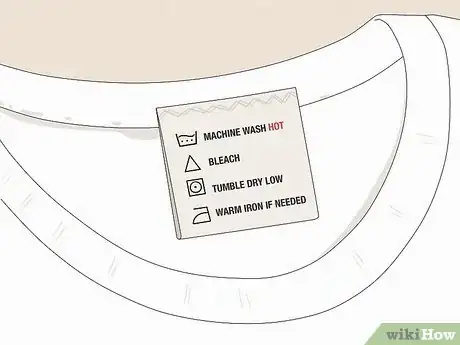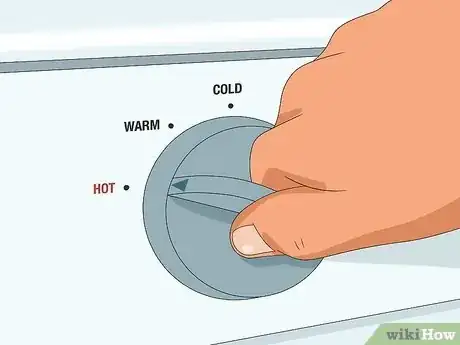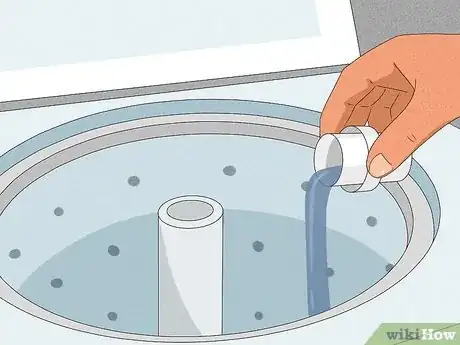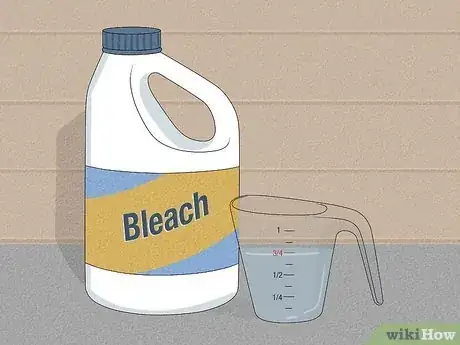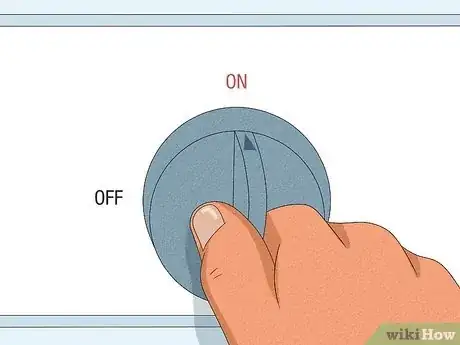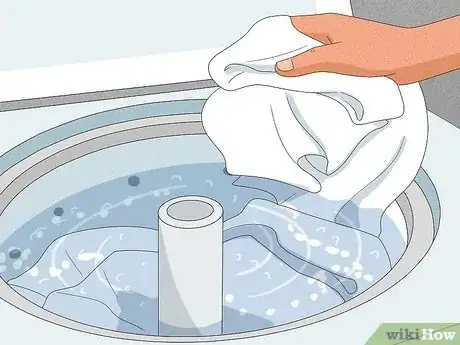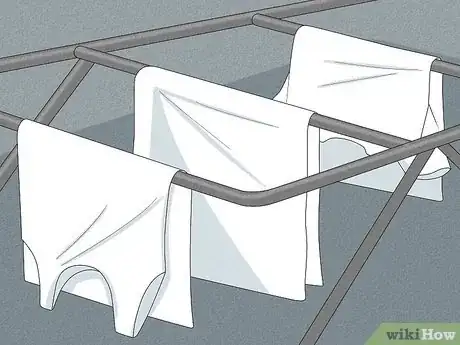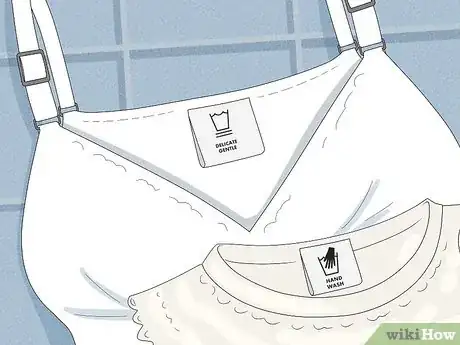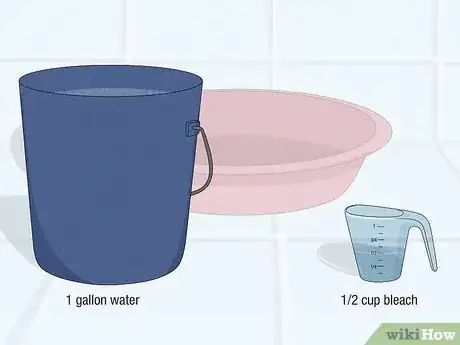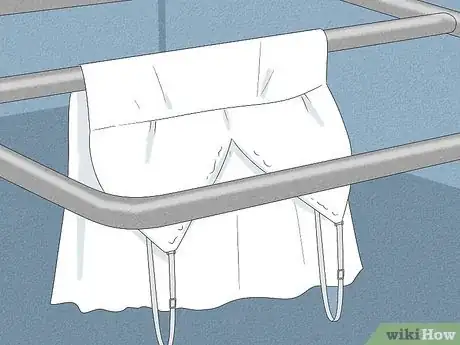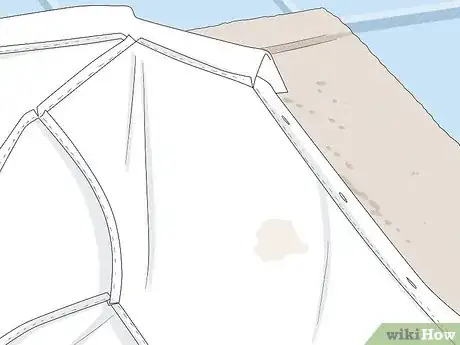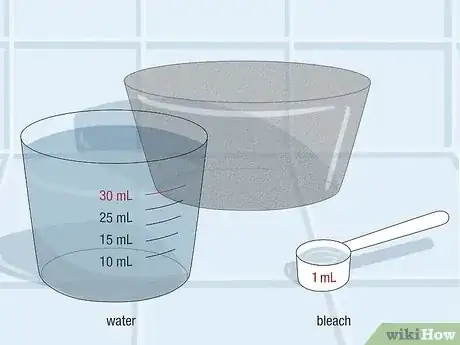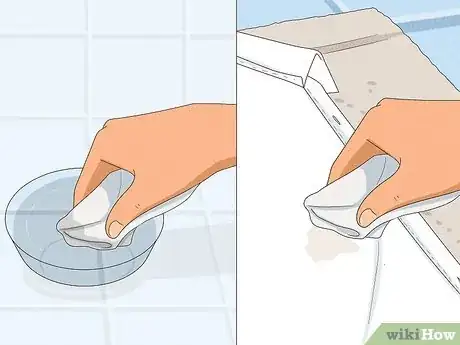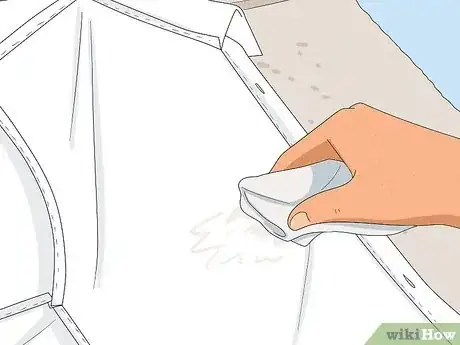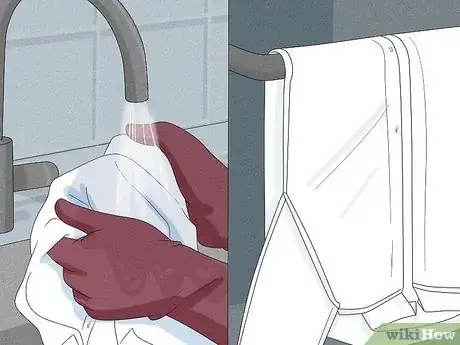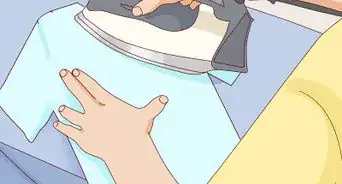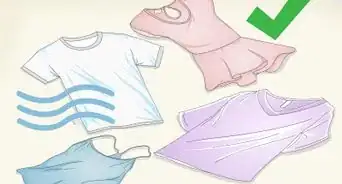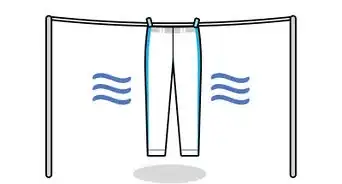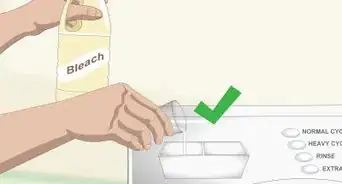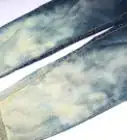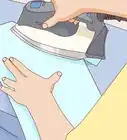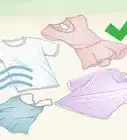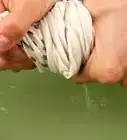This article was co-authored by wikiHow Staff. Our trained team of editors and researchers validate articles for accuracy and comprehensiveness. wikiHow's Content Management Team carefully monitors the work from our editorial staff to ensure that each article is backed by trusted research and meets our high quality standards.
wikiHow marks an article as reader-approved once it receives enough positive feedback. In this case, several readers have written to tell us that this article was helpful to them, earning it our reader-approved status.
This article has been viewed 1,265,228 times.
Learn more...
White clothing tends to get a bit dingy and lose its brightness after a while. Bleaching your whites can help maintain or bring back a brighter white. You can usually just add bleach directly into a cycle of your washing machine. However, if you are cleaning delicates, then you’ll probably need to hand wash them with bleach in a basin or sink. Bleach can even be used to fade or add designs to your clothing.
Steps
Bleaching Clothes in the Washing Machine
-
1Separate out all white clothing and linens. Go through your laundry and place all of the white clothing items into a stack. Only clothing pieces that are completely white should be separated out. Only include pieces of clothing with colored stripes or designs if you are using color-safe bleach.[1]
-
2Check your clothing tags. Read each item’s tag to ensure that they all can be safely washed in a machine on the “hot” water setting. Some all-white clothing items, like a delicate lace shirt, may need to be hand-washed. Some cotton items may need to be hand-washed or spot-treated to avoid shrinking.Advertisement
-
3Set the wash cycle temperature to “hot.” Move the other settings to “regular” wash. This will ensure that the heat activates the bleach and actually whitens your clothing.[2]
-
4Pour detergent into the machine. Use the same amount of detergent that you would normally use for a load of this size. The detergent will help to remove any dirt or grime from your clothing. Pour the detergent directly into the center barrel of the machine.[3]
-
5Measure out 3⁄4 cup (180 ml) of bleach. You can pour the bleach directly into the cap of the bleach bottle to measure it. Or, you can get a measuring cup used just for cleaning purposes. Go slowly to make sure that you don’t spill.[4]
- If the load fills over ½ of the machine, then add a bit more bleach. If the load is under ¼ of the machine, then you can put a little bit less in.
- There are a number of different types of bleach that you can use. Chlorine bleach can disinfect your laundry, but may hurt delicate fabrics. Oxygen bleach is also called color-safe or all-fabric and can be used more widely.[5]
- You can also make your own bleach solution by creating a 50-50 mixture of water and lemon juice or vinegar.
-
6Pour bleach into the washing machine dispenser. This is usually a small, enclosed space located on the upper lip of the machine. After you’ve added the bleach, the machine will release it into the wash cycle as the water heats up.[6]
- If your machine does not have a built-in bleach dispenser, simply pour the bleach directly into the wash water after the cycle has begun before adding your clothes. Wait a few minutes to let the bleach soak into the water and then put your clothes inside.
-
7Turn your washing machine on. You’ll need to either pull out or turn the power knob into the “On” position. Some machines may have a simple button that you can push to start the cycle. The machine will start filling with water right away.
- If you have a side-load washing machine, wait to start the cycle until you’ve loaded the clothes in as well.
-
8Put your clothes into the washing machine. Open the lid of the washing machine while the bleach, detergent, and hot water agitates. Drop you clothing items into the washing machine a few pieces at a time. Make sure that they are not tightly entangled. When you are finished, close the lid of the machine.[7]
-
9Dry your clothes as usual. If your clothes need to line dry, go ahead and hang them up. Otherwise, place them in the dryer on the appropriate setting.
- If your clothes aren’t as white as you’d like them to be, you can bleach them again to get the desired results.
Bleaching Clothes by Hand
-
1Separate out your delicate clothing. Look at your garment care labels and set aside clothing pieces that are labeled “hand wash” or “delicate.[8]
- If your clothes are a bit dirty, then you might want to give them a quick soak in a sink or basin with a bit of detergent before bleaching. This will make sure that the bleaching is equal across the fabric.
-
2Mix together a bleach and water cleaning solution. Plug the sink with the stopper. Then, pour into the basin 1⁄2 cup (120 ml) bleach and 1 gallon (3.8 l) of water. It’s best to use warm or hot water, but go ahead and use cold or cool instead if your garment’s care tag suggests it.[9]
- Make sure that it’s okay to use bleach on the surface of your sink, if that’s where you plan to bleach the clothes. Some sink surfaces, such as certain types of marble, can be damaged by contact with bleach.
-
3Submerge your clothes in the bleach mixture. Push the clothing down a bit to make sure that it is thoroughly saturated. You can also slowly swirl the clothes around a bit with your gloved hand, if you like. Leave the clothes to soak for at least 15 minutes.[10]
- Do not soak your unprotected hands in the bleach mixture while handling the clothes. Instead, wear solid, well-fitting cleaning gloves to protect your skin.
-
4Rinse the clothing off with cold water after 15 minutes. While wearing gloves, pull the drain on the sink or carefully transfer each piece of clothing from the basin to a sink for rinsing. Turn on the cold water tap and hold each item under it. This helps to rinse the chemicals away. [11]
-
5Hang up or lay each clothing piece down to dry afterwards. Most delicates cannot go directly into a dryer. Instead, carefully arrange each damp item on a stand-up drying rack. Or, place a towel down on a hard surface and place your clothing item flat on it.
Applying a Bleach Spot Treatment
-
1Make sure the stain isn’t oil-based. To do a bleach spot treatment, the clothing must be white. The stain must also be a certain type, such as coffee or grass. Bleach doesn’t effectively lift out stains that are oil-based, like mechanic’s grease. In fact, you may worsen the stain by applying bleach to it.[12]
- If you are dealing with an oil-based stain, you may want to take the clothing piece to a professional dry cleaner. They will have chemicals that may be more effective than bleach.
-
2Set down a clean rag on a work surface. It’s best if you use a sturdy, flat surface, such as a table or countertop. Lay down a clean cotton rag over the area. Then, place the stained spot directly on top of the rag. You want the rag to be thick enough to absorb any excess bleach.[13]
-
3Position the stain facing downward. This makes the backside of the stain visible for treatment. When you apply bleach to the stain, it will loosen and fade into the towel below. If the stain is on a shirt, place a towel or rag in between the 2 shirt layers.
-
4Create a bleach and water solution. In a small bowl, mix 1 part bleach to 30 parts water. Swirl the solution around a bit with a spoon, so that it is fully mixed. Just make the minimum that you think you’ll need and re-mix if you need more.[14]
-
5Dampen a clean white cloth with the solution. Use a cloth that you don’t mind getting stained. Dip the edge of the cloth into the mixture and then apply it to the surface of the stain. You may need to move the rag around to dip fresh areas into the solution as the stain begins to come up.
-
6Rub the stain with light strokes. Move the cloth with gentle pressure from the outer edges of the stain inwards. This will keep the stain from spreading. Keep going until the stain begins to lift.[15]
-
7Wash item as per care instructions. Check to see if stain is fully removed before machine washing or drying, which could cause a stain to set. Once the stain is completely gone, you can place the clothes in a washer and dryer according to the care instructions. Or, you can hand wash and line dry if the item is a delicate.[16]
Community Q&A
-
QuestionWhat does the triangle with lines through it on the tag in clothing mean?
 Community AnswerIt means "do not bleach." Do not use bleach of ANY sort on your clothing with that tag.
Community AnswerIt means "do not bleach." Do not use bleach of ANY sort on your clothing with that tag. -
QuestionWhat should I do if my white top turned pink when I bleached it?
 Community AnswerThere's not much you can do. You can try to bleach it again by soaking your top in 2 liters of warm water with 1/2 cup of bleach.
Community AnswerThere's not much you can do. You can try to bleach it again by soaking your top in 2 liters of warm water with 1/2 cup of bleach. -
QuestionDoes soaking in bleach shrink clothing?
 Robin SagerCommunity AnswerNot in most cases. However, some cotton clothing can shrink if left in bleach (or any water solution) too long. That is why it is important to read the care tags of your garments carefully. If you are worried about a garment shrinking, you may only want to wash it for the minimum about of time.
Robin SagerCommunity AnswerNot in most cases. However, some cotton clothing can shrink if left in bleach (or any water solution) too long. That is why it is important to read the care tags of your garments carefully. If you are worried about a garment shrinking, you may only want to wash it for the minimum about of time.
Warnings
- Make sure to store bleach in an area that is not accessible to children.⧼thumbs_response⧽
- Do not mix bleach with other chemical products, such as ammonia. This can create fumes that are deadly or damaging if inhaled.⧼thumbs_response⧽
References
- ↑ https://www.clorox.com/cleaning-and-laundry-tips/laundry/laundry-advice/how-to-use-bleach/#Ez6VfCu1trrPQ4KW.99
- ↑ https://www.clorox.com/cleaning-and-laundry-tips/laundry/laundry-advice/how-to-use-bleach/#Ez6VfCu1trrPQ4KW.99
- ↑ https://www.clorox.com/cleaning-and-laundry-tips/laundry/laundry-advice/how-to-use-bleach/#Ez6VfCu1trrPQ4KW.99
- ↑ https://www.clorox.com/cleaning-and-laundry-tips/laundry/laundry-advice/how-to-use-bleach/#Ez6VfCu1trrPQ4KW.99
- ↑ https://www.thespruce.com/types-of-bleach-1900685
- ↑ https://www.clorox.com/cleaning-and-laundry-tips/laundry/laundry-advice/how-to-use-bleach/#Ez6VfCu1trrPQ4KW.99
- ↑ https://www.clorox.com/cleaning-and-laundry-tips/laundry/laundry-advice/how-to-use-bleach/#Ez6VfCu1trrPQ4KW.99
- ↑ https://theidleman.com/manual/advice/how-to-fade-clothing/
- ↑ https://theidleman.com/manual/advice/how-to-fade-clothing/
- ↑ https://theidleman.com/manual/advice/how-to-fade-clothing/
- ↑ https://theidleman.com/manual/advice/how-to-fade-clothing/
- ↑ https://www.cleanipedia.com/gb/laundry/how-to-bleach-clothes
- ↑ https://www.cleanipedia.com/gb/laundry/how-to-bleach-clothes
- ↑ https://www.cleanipedia.com/gb/laundry/how-to-bleach-clothes
- ↑ https://www.cleanipedia.com/gb/laundry/how-to-bleach-clothes
- ↑ https://www.cleanipedia.com/gb/laundry/how-to-bleach-clothes
About This Article
To bleach your clothing, start by setting the washing machine cycle on “hot,” because the heat will activate the bleach and whiten your clothes. Next, add the usual amount of detergent to the wash basin along with your white clothes. Then, measure out 3/4 cup of bleach and pour it into the dispenser of your machine. Run the cycle on your washing machine, then dry your clothes as usual. For tips on using bleach as a spot treatment for tough stains, read on!

